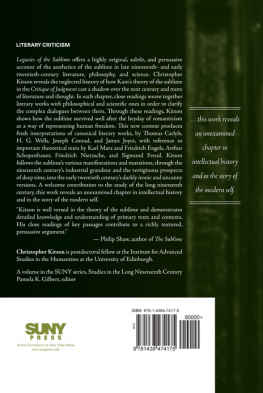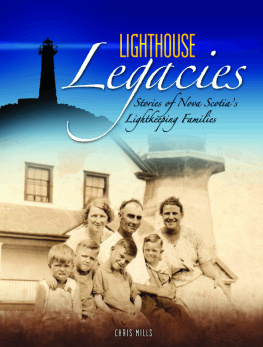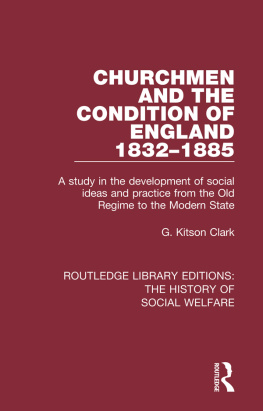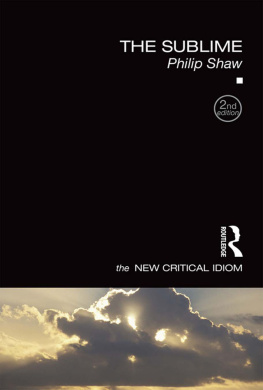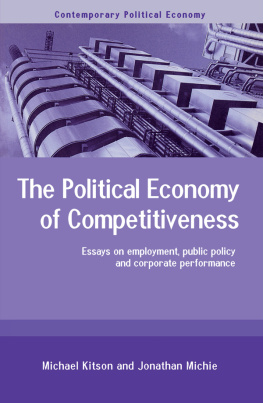Kitson Christopher - Legacies of the Sublime
Here you can read online Kitson Christopher - Legacies of the Sublime full text of the book (entire story) in english for free. Download pdf and epub, get meaning, cover and reviews about this ebook. year: 2019, publisher: State University of New York Press, genre: Religion. Description of the work, (preface) as well as reviews are available. Best literature library LitArk.com created for fans of good reading and offers a wide selection of genres:
Romance novel
Science fiction
Adventure
Detective
Science
History
Home and family
Prose
Art
Politics
Computer
Non-fiction
Religion
Business
Children
Humor
Choose a favorite category and find really read worthwhile books. Enjoy immersion in the world of imagination, feel the emotions of the characters or learn something new for yourself, make an fascinating discovery.
- Book:Legacies of the Sublime
- Author:
- Publisher:State University of New York Press
- Genre:
- Year:2019
- Rating:4 / 5
- Favourites:Add to favourites
- Your mark:
- 80
- 1
- 2
- 3
- 4
- 5
Legacies of the Sublime: summary, description and annotation
We offer to read an annotation, description, summary or preface (depends on what the author of the book "Legacies of the Sublime" wrote himself). If you haven't found the necessary information about the book — write in the comments, we will try to find it.
Legacies of the Sublime — read online for free the complete book (whole text) full work
Below is the text of the book, divided by pages. System saving the place of the last page read, allows you to conveniently read the book "Legacies of the Sublime" online for free, without having to search again every time where you left off. Put a bookmark, and you can go to the page where you finished reading at any time.
Font size:
Interval:
Bookmark:

OF THE
SUBLIME
SUNY series, Studies in the Long Nineteenth Century
Pamela K. Gilbert, editor
OF THE
SUBLIME
Literature, Aesthetics,
and Freedom from
Kant to Joyce
CHRISTOPHER KITSON

Published by State University of New York Press, Albany
2019 State University of New York
All rights reserved
Printed in the United States of America
No part of this book may be used or reproduced in any manner whatsoever without written permission. No part of this book may be stored in a retrieval system or transmitted in any form or by any means including electronic, electrostatic, magnetic tape, mechanical, photocopying, recording, or otherwise without the prior permission in writing of the publisher.
For information, contact State University of New York Press, Albany, NY
www.sunypress.edu
Library of Congress Cataloging-in-Publication Data
Names: Kitson, Christopher, 1987 author.
Title: Legacies of the sublime : literature, aesthetics, and freedom from Kant to Joyce / Christopher Kitson.
Description: Albany : State University of New York Press, 2019. | Series: SUNY series, studies in the long nineteenth century | Includes bibliographical references and index.
Identifiers: LCCN 2018027699 | ISBN 9781438474175 (hardcover : alk. paper) | ISBN 9781438474199 (e-book)
Subjects: LCSH: Sublime, The, in literature. | Aesthetics in literature. | Sublime, The. | Kant, Immanuel, 1724-1804--Influence.
Classification: LCC PN56.S7416 K58 2019 | DDC 801/.93dc23 LC record available at https://lccn.loc.gov/2018027699
10 9 8 7 6 5 4 3 2 1
Chapter 1.
Fear and Freedom: The Legacies of the Sublime
Chapter 2.
The Awakening of a Manchester: The Communist Manifesto, Chartism , Industrial Spectacle, and the Communist Subject
Chapter 3.
Orders of Magnitude: The Time Machine , Deep Time, and Wellss Mathematical Sublime
Chapter 4.
Details and Detonators: The Secret Agent , Schopenhauer, Nietzsche, and the Ironizing of the Sublime
Chapter 5.
Journeys through Nighttown: Circe, The Uncanny, and the Inhabited Subject
Conclusion
The Sublime beyond the Uncanny
I would like to thank my colleagues at the School of English at the Queens University of Belfast, who provided the environment in which this book could be nurtured, shaped, and realized. In particular, I am grateful to Daniel Roberts, Moyra Haslett, David Dwan, Leon Litvack, Joanne Burns, Joanne Davies, Patricia McCann, Mark McGahon, Charlie Small and John Heaney for their help, advice, and support. Thanks are also due to Andy Smith of Sheffield University, who provided me with a judicious eye and very useful direction. My greatest debt of all, however, is to Brian Caraher, whose diligent help and very many erudite and thoughtful conversations have more than anything else made this book it what it is.
The final stages of work were completed at the Institute for Advanced Studies in the Humanities at the University of Edinburgh, to whom I would like to express my deep gratitude for the time, resources, funding, and stimulating environment they provided. This book would also simply not exist without the generous assistance of the Arts and Humanities Research Council, who provided me with a doctoral studentship.
I am grateful also to the staff and readers at SUNY Press for the care with which they guided this book into production.
More personally, I would like to thank my family and friends. My parents have been invaluable in their support all through the time I was working on this book. Most of all, my deepest thanks go to my wife Felicity, who has been by my side through everything.
| A | Anticipations |
| CJ | Critique of the Power of Judgment |
| CLJC | Collected Letters of Joseph Conrad |
| DF | The Discovery of the Future |
| FLT | First and Last Things |
| MECW | Marx Engels Collected Works |
| MEW | Karl Marx Friedrich Engels Werke |
| OED | Oxford English Dictionary Online |
| PP | Practical Philosophy |
| SA | The Secret Agent |
| SE | The Complete Standard Edition of the Works of Sigmund Freud |
| SR | Sartor Resartus |
| TM | The Time Machine |
| U | Ulysses |
| WWR | The World as Will and Representation |
CHAPTER 1
The Legacies of the Sublime
W hen Immanuel Kant included the Analytic of the Sublime in his 1790 Critique of Judgment , he stood in a tradition of aesthetic speculation reaching back over a century. The sublime had been a staple of philosophy and criticism ever since Boileaus 1674 translation of Longinus. The category was discussed by authors from Addison, Burke, and Kames to Herder and Mendelssohn. It had been brought to bear on topics from art to ethics, history, and theology, and along the way it articulated much about how eighteenth-century subjects thought, felt, and understood themselves. Yet in the period after the third Critique , the sublime lost its ubiquitous place. By the middle and late nineteenth century, it became rare as an explicit topic of discussion. This remained the case until the closing decades of the twentieth century, when the category was resurrected by postmodern theorists with literary critics and, more recently, analytic philosophers following them. With this, the sublime has once again become a mainstay of scholarly rumination, the subject of copious debate about its nature and relevance to the experience of modern life.
This view of the sublimes uneven history, its career encompassing ubiquity, dissolution and a long dormant period as well as a sudden and seemingly unbidden return to prominence, leaves some important questions unanswered. Did the sublime really disappear without trace in the early nineteenth century? If so, why was it taken up again so readily in the late twentieth? If the postmoderns did not pull the sublime from oblivion, or invent a new one from whole cloth, what was its status in the later nineteenth and early twentieth centuries? In fact the view of the sublime as a phenomenon relevant only to two isolated historical moments, while it is an important starting point, is incomplete. It masks a deeper story of how talk about this idea has come to define modern culture in profound ways. Appreciating this involves considering the sublime not only as part of the eighteenth-century or postmodern zeitgeist, but as a category which shaped the debates and influenced the imaginations of those throughout the intervening period. The legacy of the eighteenth-century sublime is a pervasive way of thinking about the modern subject in philosophy and literature and it is in the ostensible gap of the late nineteenth and early twentieth centuries that this more deeply felt influence shows itself.
Scholarship about the fate of the sublime in the nineteenth century has recently tended towards a fuller view of its influence. The key issue is the sublimes strangely ambivalent relationship to romanticism. The great majority of the major texts on the sublime were written well before the close of the eighteenth century: Addisons writings in the Spectator (17121714), Burkes Enquiry (1759), and Kamess Elements of Criticism (1765) are examples (Ashfield and de Bolla). High romantic authors such as Wordsworth and Coleridge do indeed write on the sublime, but they tend not to give the term quite the prominence it has for, say, Burke. Yet for all this, the sublime is largely held to be a crucial concept for understanding the culture of romanticism. Critical works such as Thomas Weiskels The Romantic Sublime and Frances Fergusons Solitude and the Sublime successfully apply the concept to romantic texts. These studies follow Samuel Monks influential study The Sublime , which advances the thesis that the eighteenth-century sublime was a crucial element in the large-scale cultural shift from the Augustan to the romantic. In all, there appears to be something of a paradoxical relationship between the sublime and romantic culture. This is summed up by James Kirwan in his Sublimity : [t]he period that saw the sublime fading from aesthetics also saw the appearance of those very works that we are now most likely to think of as illustrative of the sublime (Kirwan 126). There seems to be a mismatch between the sublimes importance in the cultural climate, which is held to increase as romanticism develops, and its presence as a subject of explicit discussion, which at the same time wanes. The sublime as a culturally inflected construct clearly undergoes change in the transition from the mid-eighteenth century to the romantic period; it is no longer the favored category of critics and aestheticians that it once was. Yet it is far from clear that this change is a simple decline.
Font size:
Interval:
Bookmark:
Similar books «Legacies of the Sublime»
Look at similar books to Legacies of the Sublime. We have selected literature similar in name and meaning in the hope of providing readers with more options to find new, interesting, not yet read works.
Discussion, reviews of the book Legacies of the Sublime and just readers' own opinions. Leave your comments, write what you think about the work, its meaning or the main characters. Specify what exactly you liked and what you didn't like, and why you think so.

